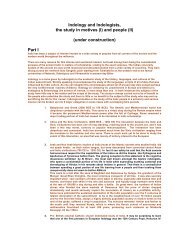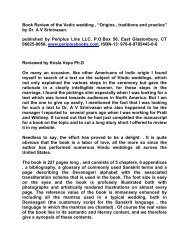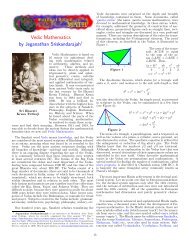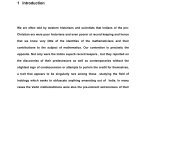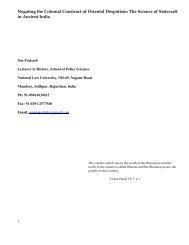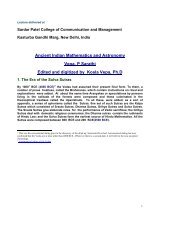The Dhaarmik Traditions - Indic Studies Foundation
The Dhaarmik Traditions - Indic Studies Foundation
The Dhaarmik Traditions - Indic Studies Foundation
Create successful ePaper yourself
Turn your PDF publications into a flip-book with our unique Google optimized e-Paper software.
53 Guna varna<br />
Vyavastha<br />
so that his varna is that of a Vaisya, unless he maintains his competency and knowledge<br />
of the Vedic scripture and adheres to the injunctions of a Brahmana. Most Indian<br />
philosophers accept the view of the Samkhya philosophy<br />
<strong>The</strong> Varna system, namely Guna Varna Vyavastha, that produced the Varnashrama<br />
Dharma was conscious of the fact that this was the world's early attempt at a<br />
meritocracy. That the system was eminently successful in its own way , I have no doubt<br />
because the resulting civilization flourished for well over 5 millennia, until its very<br />
foundations were attacked by barbarians from both within and without; by barbarians,<br />
whose notion of entertainment was to build a pyramid of skulls, in order to terrorize the<br />
local population to capitulate. <strong>The</strong> current system in place after the colonial power was<br />
done reinventing and reshaping it to its own specifications, and which goes by the name<br />
Caste, is so utterly different in all significant ways, that we can safely say it has little to<br />
do with the Hindu faith or Hindu traditions such as the Guna Varna Vyavastha. <strong>The</strong> vedic<br />
division of people into 4 Varnas (Brahmana, Rajanya, Vaisya and Shudra) is by Guna and<br />
Guna only and is known as the Guna Varna Vyavastha. <strong>The</strong> Asrama system refers to the<br />
four stages of one's life, namely Brahmacharya (life of an unmarried student), Grihasthya<br />
(life of a householder), Vanaprasthaya (life of a retired householder), sannyasa (life of a<br />
monk)<br />
54 Hinduism Also known as Sanaatana Dharma, the eternal faith; there are roughly 850 million Hindus<br />
in the world as of 2006 (see Dharma)<br />
55 Indo-Aryan<br />
languages<br />
A family of languages spoken over a large area of the Eurasian land mass;see Indo-<br />
European Languages<br />
56 Indo-European<br />
languages<br />
A family of languages spoken over a vast geographical area from India to most parts of<br />
Europe.<br />
57 Indo-Iranian<br />
languages<br />
the Indo Iranian branch of the Indo Europrean language family , spoken in central<br />
asia,iran and the Indian subcontinent<br />
58 Indology Indology is a name given by Indologists to the academic study of the history, languages,<br />
and cultures of the Indian subcontinent. Strictly speaking it encompasses the study of<br />
the languages, scripts of all of Asia that was influenced by <strong>Indic</strong> culture It may be<br />
surprising to learn that the first pioneer in Indology was the 12th Century Pope, Honorius<br />
IV. <strong>The</strong> Holy Father encouraged the learning of oriental languages in order to preach<br />
Christianity amongst the pagans. Soon after this in 1312, the Ecumenical Council of the<br />
Vatican decided that-“<strong>The</strong> Holy Church should have an abundant number of Catholics<br />
well versed in the languages, especially in those of the infidels, so as to be able to<br />
instruct them in the sacred doctrine.” <strong>The</strong> result of this was the creation of the chairs of<br />
Hebrew, Arabic and Chaldean at the Universities of Bologna, Oxford, Paris and<br />
Salamanca. A century later in 1434, the General Council of Basel returned to this theme<br />
and decreed that –“All Bishops must sometimes each year send men well-grounded in



